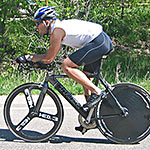Buyer's Guide To Bicycle Wheelsets
 Here at the shop we like to think of wheels as your bicycle's wings. When they're old or heavy, or beat-up and knocked out of true, you wobble along and can barely enjoy riding. Meanwhile, nicely engineered hoops, built light and strong, let you soar over the road and trail with speed, precision and grace.
Here at the shop we like to think of wheels as your bicycle's wings. When they're old or heavy, or beat-up and knocked out of true, you wobble along and can barely enjoy riding. Meanwhile, nicely engineered hoops, built light and strong, let you soar over the road and trail with speed, precision and grace.
4 Reasons Why Wheels Matter So Much
With their impossibly thin spokes, light and often skinny rims, and minimal hubs, bicycle wheels appear spider-web delicate, yet they're actually a marvel of engineering, remarkably strong and exceptionally well suited to cycling. Here's why they're so important.
1. Ride quality. Because wheels are the bike's contact points with the ground, they have a lot to do with how the ride feels. For example, a burly wheel made to withstand the rigors of downhilling resists flex more than one made for cross country, so the former will feel stiff, while the XC will be more supple. Likewise, tall-section triangular, aero triathlon and time trialing wheels slice through the wind but can't compete with the svelter all-around road rims for compliance and comfort.
2. Ease of pedaling. Wheels are constantly spinning, and most of the time it's your pedaling that's keeping them turning. Because of inertia, the more weight there is at the outside of the wheels (the rims, tubes and tires), the more effort it takes to get your wheels turning. Think about if you had car wheels and tires on your bike instead of bicycle ones and you can see how heavy means less efficiency and more effort to keep your machine going. This is especially noticeable when you're accelerating and climbing; not as much when you're riding the flats at a steady pace (heavier hoops actually hold your speed better). 3. Reliability. As we pointed out in our first reason, the wheels are what's between you and the ground. They must support your weight and keep rolling no matter what you ride over or through. In the case of rim brakes, they need to stay true and round so your brakes work safely too. Poor quality wheels won't do these things for long. Quality models will roll true and strong for years.
3. Reliability. As we pointed out in our first reason, the wheels are what's between you and the ground. They must support your weight and keep rolling no matter what you ride over or through. In the case of rim brakes, they need to stay true and round so your brakes work safely too. Poor quality wheels won't do these things for long. Quality models will roll true and strong for years.
4. Functionality. As the hardest-working parts on your bike, your wheels also need to match your riding style. You may buy a nice bike to ride around on and then decide to mount racks and bags to haul heavy groceries or tools. Pretty quickly this way you can ask more of your stock wheels than they were built to handle. Or, maybe you want to turn your bike into a fixie and won't be happy until your rims are the right color? With today's wide range of purpose-built wheels, satisfying these needs (and more), with new wheels is easy.
 Choosing Wheels
Choosing Wheels
Once you've decided it's time for a wheel upgrade, how do you know how to select the best ones? It's actually pretty straightforward. You already know what bike they're for, so simply check the label on the tire to find the size. Write that down. That's the tire size but also the wheel size and it's the starting point for getting the right wheels. If you're not sure you can also just ride by the shop and we'll take a look and tell you.
Next think about what you want these new wheels to do for you. Maybe you're replacing old, bent wheels and looking for a set that'll hold up better to the way you ride. You could be looking for an easier ride from some lighter, better-designed wheels. Or, it could be a second set of "event" wheels to give you an advantage on certain types of courses, or race wheels to replace your heavier, slower training wheels on the big day. If you can tell us what you're looking for in wheels we can point you toward a perfect pair.
Options And Tips On Deciding
Following are some of the common features found on today's road, tri and mountain wheels, and some guidelines to help you determine what's best for you, your bicycle and your riding.
Wheel Types
Obviously, there are wheels for the dirt and different wheels for the road so that's one starting point. If you're looking at off-road wheels you decide, based on your bike, whether they're disc-brake specific or ready for rim brakes. The difference is that wheels for discs have hubs that accept the rotors (what the disc brakes grab), and usually have rims without a true braking surface, which saves weight at the rim.
looking at off-road wheels you decide, based on your bike, whether they're disc-brake specific or ready for rim brakes. The difference is that wheels for discs have hubs that accept the rotors (what the disc brakes grab), and usually have rims without a true braking surface, which saves weight at the rim.
Rim-brake wheels don't have any provision for attaching rotors and feature rim sides made to withstand the wear and tear of rim brakes. Note that if you need wheels to use on two bikes, one with discs, one with rim brakes, you can find those too. They'll have a rim made for braking and a hub setup to accept rotors.
When it comes to wheels for the road, there are all-around models made to deliver excellent ride quality and durability that work great for upgrading an old pair. There are also models designed to give you some free speed according to how you use them. For example there are climbing wheels that are built lighter for easier ascending, aero wheels practically invisible to the wind and all-around road wheels that combine lightness, aerodynamics and a compliant ride.
Tube or Tubeless
Another choice is whether to get dedicated "tubeless" wheels or standard models. Tubeless means that the rim is made to provide an airtight seal for use with tubeless tires. This is important since you run tubeless tires without inner tubes, which allows running lower pressures for a smoother ride and more traction and control.
It's possible with a conversion kit to install tubeless tires on standard wheels, however, getting the dedicated wheels made for tubeless means easier tire installation and no need for the special conversion rim strips. So, if you enjoy riding tubeless on the pavement or dirt, you should consider upgrading to tubeless wheels. Note that these wheels all accept standard tires with tubes too.
Tubular Wheels
If you race the road you might want to consider "tubular" wheels, which are the lightest available and most unusual. They require special tires called "tubulars" or "sew-ups" (because the tire is actually sewn together around the tube). These tires have truly round profiles and they are installed by gluing them to the rim. Proponents of this design love the quickness and suppleness of these featherweight, round-profile tires and don't mind the more difficult mounting procedure.
Rim Shape
The shape of the rim has a lot to do with how the wheel rides. The stiffer the rim the more you feel the road and trail. And, the more triangulated and deep (tall) a rim is, the more rigid the ride. Most of the time, on smooth surfaces you'll notice stiffness less than on rougher ones. And, stiffness is a good thing for racing and hammering because more of your power makes it to the road.
road and trail. And, the more triangulated and deep (tall) a rim is, the more rigid the ride. Most of the time, on smooth surfaces you'll notice stiffness less than on rougher ones. And, stiffness is a good thing for racing and hammering because more of your power makes it to the road.
If you're looking for slippery wheels for an advantage racing triathlons or time trials, or even for getting maximum rest sitting in the pack at your road races and then sprinting faster for the line, look at wheels with deep-section rims, which can be as tall as 90mm or more. For lighter weight and better handling in crosswinds, check out wheels with smaller profiles like 28mm.
Besides how deep the rim is, the width makes a difference too. Wider rims (about 23mm) tend to offer a nicer ride and more durability since they spread the tire sides allowing more air and flotation. Meanwhile, narrower (usually 19mm) means more aero advantages and lighter weight.
Rim Material
While you can still find bicycles with steel wheels, they're pretty much not used on nice bicycles anymore due to their weight and even more important, how slick they are when it rains, which compromises your braking power. Instead most wheels today feature light and durable aluminum rims. And, at the high end are carbon rims. Carbon can be molded into many shapes, can save weight, and is a nice match for full-carbon bicycles. Note that carbon rims with carbon braking surfaces require carbon-compatible brake pads, which we can supply.
Spoke Count
This is the number of spokes used in the wheels. Modern wheelsets typically use the minimum number required to suit the wheel design, more for heavier uses, less when the wheels aren't pushed so hard.
We can discuss what's right for you in person, as learning more about you and how you ride tells us a lot. You can start by thinking about how much you weigh, the condition of the surfaces you ride on and how you ride, such as long hard miles, weekend fun riding, racing, etc. In general bigger riders who ride a lot should use more spokes and lighter cyclists on smoother surfaces can get by with fewer.
 Hubs
Hubs
Wheels spin on the hubs, which are the component at the center of the wheel where the spokes originate. They have bearings and axles inside, and on the drivetrain side either threads for cogs or a "freehub," that the cluster of gears (called the "cassette") mounts on. Cassettes are sold separately.
All our wheels come with quality hubs that are built to last, easy to service and super smooth. As you move up in wheel quality and price, the hubs get lighter with better alloys, or carbon, and more advanced, with superior bearings, axle parts and seals. Since the cassette drives the wheels, the freehub often improves too.
Come Check Out Some Wheels In Person
We hope these basic tips take some of the mystery out of wheel shopping. Be sure to swing by to see our wide selection of wheels and learn more about them. And don't hesitate to ask if you have any questions. In our experience upgrading your wheels is second only to getting a new bicycle so we're always happy to help. Thanks for reading!
